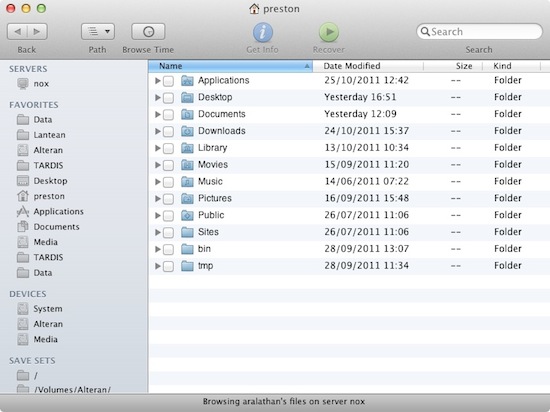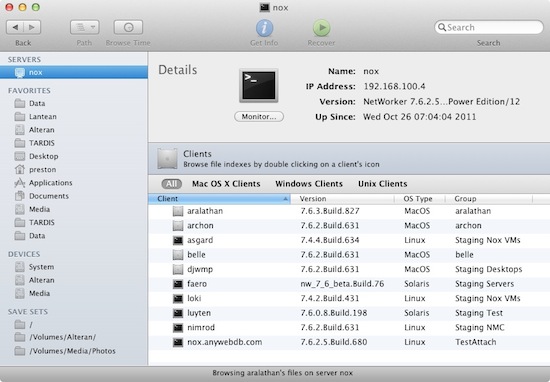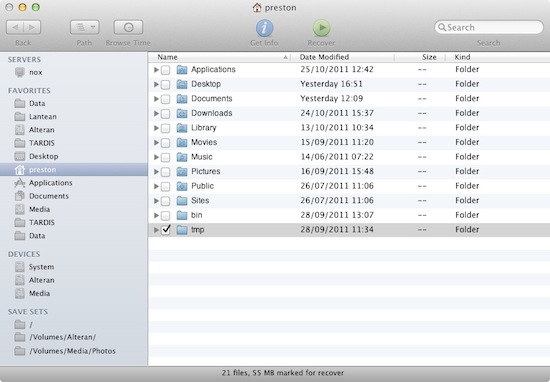It seems to be a growing trend – EMC update NetWorker on the same day that I’m sick as a dog and unable to concentrate enough to blog on it.
I thought I’d run through the release notes new features and provide a bit of a summary of the changes. The full release notes are available via PowerLink, or here.
Slap another GUI on the barbie, will ya?
As a Mac user, I find this a really nice treat. EMC have finally included a recovery GUI for the Mac OS X client. It was always a bit of an omission that the most GUI-centric platform supported by EMC happened to have no client GUI support whatsoever. For what its worth, I’m not overly concerned about a lack of a backup GUI for the platform, since that’s disappeared from other platforms, and most backups should be done via a schedule anyway.
And for what it’s worth, it’s a damn fine GUI:


 There were, in beta testing, a few minor glitches: I’ve not yet had the time to run the released version through its paces yet, but as you’ll note from the screen shots above, in “Favorites”, for instance, a few drives are listed twice. Though, now that I think about it, the drives that were listed twice were filesystems that had been rebuilt and/or replaced on my Mac Pro during the beta test period, so perhaps for some reason they were showing up separately.
There were, in beta testing, a few minor glitches: I’ve not yet had the time to run the released version through its paces yet, but as you’ll note from the screen shots above, in “Favorites”, for instance, a few drives are listed twice. Though, now that I think about it, the drives that were listed twice were filesystems that had been rebuilt and/or replaced on my Mac Pro during the beta test period, so perhaps for some reason they were showing up separately.
The other point for the Mac in 7.6 SP3 of course is support for Lion. Don’t however get your hopes up – there’s no mention of 7.6 SP3 supporting backup/recovery of the hidden recovery partition that Lion installs, and given how Apple have done their best to lock down that hidden recovery partition, I’m hardly surprised.
That being said, I’ve had the beta of 7.6 SP3 running on my Macs for some time now, and the support for Lion has been very good thus far.
Default, Default!
There’s been some changes to standard system defaults, and for the most part I really like them. This is minor stuff, to be sure, but it’ll certainly help sites where NetWorker is being deployed for the first time, or where the NetWorker administrators are relatively novice at the product.
For a start, security – at long last, RAP Logging has been enabled by default, and in fact will be enabled on an upgrade, if I’m reading the release notes correctly. This is a simple yet important change; it’s a recognition that auditing and security control is important, and it turns on something that can make back-tracking changes at a site trivial. Every time I do a backup audit on a client, I look to see whether Monitor RAP is enabled. With a bit of luck as companies move to 7.6 SP3 I’ll have less to rabbit on about there.
The devil is in no longer in the details for the start time – I always thought one of the original programmers at Legato must have had a warped sense of humour to have a default group start time of 3.33. Was it because 6.66 is not a valid time? To be sure in a very small environment, a start time of 3.33 was often OK for businesses, but the amount of data to be backed up has grown, and NetWorker is well entrenched as an enterprise product, and a default start time so close to start of business hours always irked me a little. Now it’s been set to 21.00 instead, a much more suitable time.
The nsrmmd polling, control and restart intervals have all been increased; they’re now 15, 10 and 5 minutes respectively. That’s higher than the previous defaults, but actually far more sensible. Those previous intervals were oriented at small LAN networks with a minimal number of backup devices. We’re now increasingly seeing environments with hundreds of backup devices, and the default polling intervals were something that you’d have to change as soon as you went beyond a relatively small number of devices anyway. That’s another bugbear that’s gone.
Max sessions for AFTD/file devices is now set to 32 for all new devices created after the upgrade. If I recall correctly, for most of 7.6 it’s been the case that new AFTD/file devices would get target 1/max 4 by default. I’m not sure I particularly like this change, but I’ll live with it. The challenge with having large numbers of max sessions for disk backup devices is that I’ve seen it encourage sites to not really take time to think about the disk layout. In particular, some sites end up creating a few but large disk backup devices, which results in poor striping of the backup writes and reads across the per-filesystem spindles. That is, a 6TB single disk backup unit made up of 5 x 2TB drives in RAID-6 is not going to give as good a performance as say, 2 x (5 x 1TB drives in RAID 6). I.e., I worry this may leave people thinking they can get away with a higher number of streams to each disk backup unit. Please, make sure you don’t get trapped into that ‘false economy’ thinking. On a similar front, the default max sessions for data domain devices has been set to 10. I suspect again for Boost devices that it may be a little optimistic, but we’ll wait and see.
The Company That Dare Not Speak Its Name
Its safe to say that there’s a great deal of rivalry between NetApp and EMC. If you follow EMC/NetApp employees on Twitter, sometimes the discussions descend into thinly disguised vitriol. There’s bad elements to that of course, but it does speak to the passion that each company has for their own products and their own way of thinking.
That being said, 7.6 SP3 has introduced the ability to do block-level backups of SnapMirror volumes on NetApp, which can make a big difference when you’re backing up highly dense NetApp filesystems.
Ultimately, in talk of “big data” and consolidation, all the vendors have to play together much more nicely, and I’m happy to see additional integration options between NetWorker and NetApp.
NetWorker Health Check
EMC provide a freebie utility called the Health Check Tool, and it’s worth checking out. There’s a new version, 3.1, which supports NetWorker 7.6 SP3. (Of course, you can also get a bunch of diagnostic tools in IDATA Tools, too.)
Still, if you like working within the confines of a GUI, the NetWorker Health Check tool is a handy utility to have in your environment.
I’ll multi-your-plex
This is a nice one – and I’ll be interested to play with it ASAP on a Data Domain host. So long as you’re running DDOS 5.x or higher, NetWorker will work better with deduplication while still multiplexing to a DD VTL. Previously this hasn’t been the case – the way NetWorker multiplexes the data stream somewhat incompatible with most forms of deduplication. Clearly the integration of NetWorker and Data Domain in the BRS family continues to have benefits – Data Domain OS 5.x must have some level of understanding of a multiplexed NetWorker data stream and be able to perform some deduplication on it.
Now, the release notes state clearly you won’t still get optimal deduplication rates, and it will create a performance hit during the backup process – however!, that being said, if your back is up against the wall and you have a choice between stacking on a bunch of storage node enabler codes to support 128 virtual drives on a single host, or using fewer virtual drives with a lower deduplication ratio/speed, this may be beneficial to consider.
vSphere 5 Support
It had to be said, the Oregon State Highway Division not only had a whale of a problem on its hands…
Sorry, I got distracted. It had to be said that it took NetWorker a while to support the VADP backup options under ESX 4.x, etc. While vSphere 5 has been out for a while now, the elapsed time has been much smaller, and NetWorker 7.6 SP3 features vSphere 5 virtual machine/guest support.
Alphawhat?
AlphaStor continues to limp along, and AlphStor 4.0 support is included with 7.6 SP3.
Personally, I think it’s time for AlphaStor to be dropped as independent problem. Fold library virtualisation and the additional media management options directly into the NetWorker product, and ditch AlphaStor as a separate licensed option, please, EMC.
Additional Platform Support
Solaris 11 – remember that champion Unix platform that people used to either love or hate, but now people seem to universally hate since Uncle Larry purchased it? Well, Solaris 11 has official support with NetWorker 7.6 SP3. Don’t get me wrong, I’m not knocking EMC for including support for Solaris 11, but I stand by an earlier piece, RIP Solaris.
CentOS 6.x support … ahem! … RedHat Enterprise Linux 6.x support has been enhanced to include RHEL 6.1. I’m sure this will see a large number of companies currently using CentOS to look at upgrading their release, since they get a better bang for buck quality of support for using CentOS as they do from using other commercial Linux releases.
Unky Larry’s Other Product
Java 7 is now supported with NetWorker.
Upgrading
As always, before you upgrade NetWorker:
- Read the release notes carefully. See what has been fixed from previous releases, and see what are the known issues of the new release;
- Make sure you have a good, reliable backup of your bootstrap and index region before doing the upgrade;
- Have available, ready to install, the version of NetWorker you’re currently using plus any patches you may have applied just in case you need to back-rev for some reason;
- Have a change window big enough to allow you to run some preliminary tests after the upgrade;
- Despite it not being documented anywhere, my honest opinion is that on any NetWorker server upgrade, you should remove the /nsr/tmp directory after shutting it down but before doing the upgrade. This can prevent a lot of random issues.
- Always upgrade your storage nodes at the same time as your backup server. I know EMC says you don’t have to. I disagree, however. (As do my colleagues.)
No word of key management for LTO (and other) tape drives that can do in-line encryption?
Buying a separate appliance is a bit of overkill for many, and having one’s library do it (e.g., Quantum) is a bit too much lock-in then what we’d really want. Of course having one’s backup software hold the keys is also a form of lock-in I guess. 🙂
NetBackup has had this functionality for a while, so I’m curious to know if Networker will ever get it.
Perhaps when OASIS’ “Key Management Interoperability Protocol” (KMIP) becomes more mainstream?
http://www.oasis-open.org/committees/tc_home.php?wg_abbrev=kmip
I really don’t know if/when NetWorker will get key management for tapes. Given EMC’s general direction of trying to steer the industry away from tape usage, I can’t see it being a high priority given that it will interoperate with an environment where the tape encryption is handled at the OS/hardware level instead…
Well, they can steer away all they want, but if I have/want to keep some data around for 6-18 months, I don’t have to have to keep it on disk (using heat and power).
And doing encryption at the OS/hardware kills the built-in compression on tape drives. Quite often we have semi-idle CPUs, but doing all that would kill any spare breathing room. Somehow I don’t think NetWorker uses the encryption instructions built into some modern CPUs either (AES-NI on Intel, and the stuff under SPARC T1/2/3/4).
Oh well.